The Floor is Lava – Curling Edition
a hot take on an age-old game
Artist’s Statement
On April 28, 3073, a meteorite struck Earth, triggering a volcanic chain reaction and turning the continent into a lava hellscape. Resources were scarce and the survivors formed factions to maximize their chance of survival. They relied on life rafts with titanium-laced microfabric as their means of transportation across the lava rivers.
Two factions, the Ashen Alliance and the Obsidian Order, came to dominate the territory on the edge of the Shadow Vertex. Just as both sides were on the brink of running out of supplies, a military helicopter was spotted releasing packages above a nearby lava pool. As the packages parachuted down, both factions knew there wouldn’t be enough supplies for everyone. Who will survive: You or them?
Introducing: The Floor is Lava – Curling Edition! Combining the classic childhood game of The Floor is Lava—jumping across couches and chairs without touching the floor—with the strategic finesse of curling, this adrenaline-pumping social game promises endless hours of fun, laughter, and friendly competition.
Picture this: the intense excitement of curling, but instead of sliding stones, you’re sending your friends gliding across the floor on rolling chairs! Think of it as a life-sized tabletop game, where your buddies are the pieces and teamwork is the key to victory.
FILCE transforms any space into a thrilling, fast-paced arena where players must navigate their teammates across the perilous lava-filled floor to the target. Put your communication and coordination skills to the test as you work together to outmaneuver your opponents and claim victory.
Whether you’re a curling enthusiast, a novice, or simply looking for a fun-filled activity for your next social gathering, The Floor is Lava – Curling Edition is guaranteed to provide a unique and unforgettable experience. Perfect for team building, parties, or just an entertaining way to spend time with friends and family, this game is sure to become an instant favorite.
Concept Map

Initial Formal Elements and Values
V1: In our first version of the game, we knew we wanted to use rolly chairs as our method of player transportation, rather than the traditional platforming and obstacle course that The Floor is Lava uses for players to jump across. Rolly chairs arguably offer the most accessibility and safety, as players with lower risk tolerance have the option to launch at slower speeds, and there are minimal requirements on physical fitness relative to platforming.
In terms of gameplay, we designed a 3v3 capture-the-flag type game where teams tried to deliver a flag to the opponent’s goal. The diagram below is a bit unnecessarily convoluted (in that there was no reason to designate a space for each individual player), but the general idea is that each team had a launch zone, team A on the left and team B on the right of the playing field. Each player could carry a flag, and if they made it into the opponent’s launch zone, the flag is scored. Whichever team scores all flags first, wins.
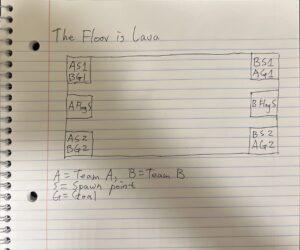

In our playtest, we discovered this map design created some significant problems. Firstly, there’s the issue of “spawn camping.” Each team can designate one or more players to be goalies, and practically block all incoming enemies from scoring. This, in effect, encouraged players to launch at significantly higher speeds in order to try and thread the needle in between gaps, or to use sheer force to ram their way into the opponent’s goal. Several players reported the desire for safety measures, such as helmets or a speed limit.
However, the use of rolly chairs was a clear success overall. Players enjoyed using this unconventional type of vehicle, which relates to our reading on how our brains are always desiring to learn new patterns. A game with walking or running would be very familiar to the players, so our use of rolly chairs prevents boredom from being able to use pre-existing knowledge. In addition, since our rules prohibit changing course after the chair has been launched, the game can also be abstracted into a physics simulation, adding in intricacies such as launch angle and speed such as those existing in pool.
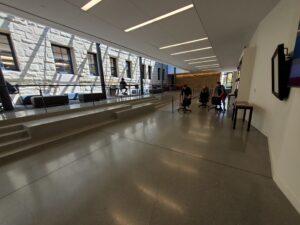
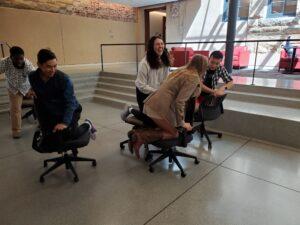
Testing and Iteration History
We went through 2 major and 2 minor iterations of the game based on playtesting feedback and reflections.
V1.5: We made many attempts to remedy our problems via different map design. We explored possibilities where the flags are placed in the middle of the map to address spawn camping, possibilities where the flags are placed along the top and bottom borders of the map (if we think about the team launch zones as being along the left and right borders), possibilities where the players in the same team were located diagonally across from each other on the map, but nothing seemed to fully address all of our problems. The most common issue still present in all of these designs is that since our game only allows for motion in one direction, any collision pretty much implies the player will be stuck somewhere in the center of the map, forcing them to reset back to spawn.
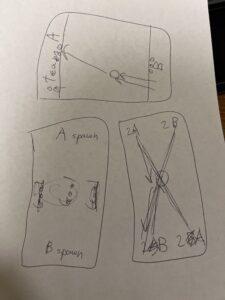
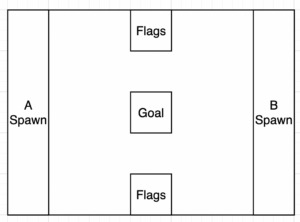
We realized our problems were inherent in the game mechanics of capture the flag. Capture the flag is a physically-confrontational game—one team is trying to prevent the other team from obtaining or scoring their flag. This means that one team will try to kill the momentum of the other team, and our game design does not have any mechanics for regaining momentum (other than by having a teammate bump into you).
We reflected on what our current design excelled at rewarding—precision in the speed and direction of launches, and we chose to use another gameplay framework that maximally rewards such precision.
V2: The Floor is Lava – Curling Edition. Rather than capture the flag, we changed the objective of the game to launch as many chairs as possible into the goal area, like curling where players on chairs take the place of curling stones.
In our two playtests of this version, the limited goal area alleviated most safety concerns, since the players must launch at a precise speed in order to not overshoot the target, which can be customized by changing the distance to the goal. In addition, since the game is now turn-based rather than real-time, it allowed for players to become much more strategic in choosing and lining up their shots.
We observed a healthy amount of discussion among team members about what strategies should be employed (e.g. “you should try to hit that chair into the goal from this angle”), which we did not observe in the previous version. In addition, we also observed the rise of trash-talking between the two teams, revealing players were embodying the competitive nature of the game.
V2.5: Since this is a game we are (in theory) going to be selling, we revised the visual elements to reinforce the core theme of the floor being lava. You can find our updated designs below. In addition, we redesigned the chairs to optimize for safety and immersion by turning them into life rafts. The updated chair design also allows for increased accessibility and potential for goofiness, as players can now launch by jumping onto them in any fashion without the fear of toppling over. Unfortunately, (for obvious reasons) we can’t actually manufacture and playtest with such a chair, but we think it would be really cool 😉
We also introduced the differing rules across the 3 rounds. This was motivated by our observation that when all 3 rounds allowed players to launch themselves, some players were able to take advantage of the iteration and rapidly learn effective launches. To keep the game constantly fresh and challenging for everyone, we decided to vary the rules across the rounds.
As players of board games and video games, we’re used to sending our troops and pieces into battle on our behalf, and we’re largely emotionally unattached to the ultimate fate of our pieces. Wanting to turn this model on its head, we took inspiration from the classic The Floor is Lava which derives fun in a very different kind of way: rather than primarily being an intellectual social exercise, The Floor is Lava embodies the risks and thrill inherent in performing challenging physical tasks. It strikes a sweet spot that balances the ever-present risk of someone slipping or falling, with the relatively minor injuries that can result, resulting in maximal thrill without fear of serious consequences. Abstracting these elements, we greatly value the sense pleasure from physical contact and challenge from performing physically challenging tasks as two of our types of fun.
Another important aspect is the social nature of our game, prominently, the teamwork and fellowship required to score as many chairs into the goal zone, and the competition aspect of also knocking out chairs that your opponent has scored. This brief description does not do the potential for teamwork and intensity of competition justice—there are a multitude of strategies that arise due to the interpersonal dynamic that wouldn’t exist in a single player game. For example, one strategy we observed in a playtest is that a team member who isn’t able to launch as far would focus on blocking the opponent rather than scoring. This strategy takes advantage of how fellowship enables specialization of players, which also modify the other teammates’ experience: now, they have a dual objective of scoring their own chair in, as well as the blocking chair. This makes the game more of a challenge for the players who are ready for such a challenge, encouraging trick shots that go beyond a single goal.
In everyday terms, we value athleticism, teamwork, and friendly competition.
Here are our formal elements:
Players: Our game can be played with at least 4 players, split into two teams, the Ashen Alliance and the Obsidian Order. 4 players seem to be the optimal number, given the typical constraints on play area any number of chairs available, though the game itself has no issue handling more players.
Objectives & Outcomes: This is a team-based game, and the objective of each team is to score more points in the goal than the opponent team. The game has 3 rounds (described below in the Procedures section), and the team that obtains the most points totaled across all 3 rounds wins. This means it is possible for a team to win, despite “losing” 2 rounds, so long as their total score at the end is higher than the other team’s. This is to ensure all 3 rounds will always be played (preventing games from ending at 2-0), and the losing team can always maintain some amount of hope for a comeback.
Procedures: As aforementioned, the game is divided into 3 rounds. Each round puts a twist on the game, to give an opportunity for different skill sets and strategies to shine. But first, let’s go over the setup and general gist of the gameplay.
To begin, each team designates one member to play rock paper scissors against the other team’s designee. The losing team will go first in round 1, and the winning team goes first in round 2. Like in curling, going first is a disadvantage in our game.
Round 1: The teams take turns launching players from the launch area toward the goal zone. In this round, players must launch themselves, through whatever means they like—running and jumping onto the chair, sitting on the chair and propelling themselves with legs, etc. After exiting the launch zone, the player must not touch the ground in any way. After all, it’s lava, ouch! Only once the player has come to a complete stop can they get up and walk back to the launch zone, leaving their chair in place. (More on the consequences of this in the Rules section below)
Each player must launch no more than once. The specific order players go in is up to the team to decide. After all chairs have been launched, count the points scored by each team and reset the playing field.
Round 2: Instead of players launching themselves, the player must be completely on the chair while a teammate helps push them. The teammate cannot step across the launch zone.
Round 3: Now, both teams perform launches simultaneously. The method of launching (self-propelled or pushed) is up to the player to decide. A person should be designated to give a countdown of 3, 2, 1, LAUNCH, and any player that exits the launch area too early or too late is invalidated (up to the discretion of the players).
Rules: If a player touches the ground in the lava zone before their chair has come to a complete stop, or if a player launches too early/late in round 3 as aforementioned, the launch is invalidated. For safety reasons, players are encouraged to jump off the chair and invalidate their own launch if they see it is going off-course. If an invalidated launch collides with previously launched chairs, their positions should be restored as best as possible.
Resources: When you purchase our box, it comes with 8 lava-proof, collision-resistant life rafts (chairs), 4 for each team. In addition, it comes with a roll of red-colored tape for denoting the launch line and the goal zone.
Boundaries: The boundaries of the game are usually the room it is played in. In the case that you might be playing this in a super large room, the boundaries can be denoted with tape. It is recommended that the goal is 40 to 60 ft away from the launch zone, though the level design is completely up to the discretion of the players.
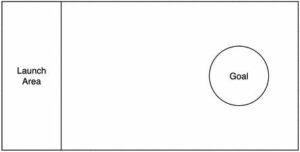
Final Prototype
Included in the box: 8x rafts, red tape, rule manual
Front of Box

Back of Box
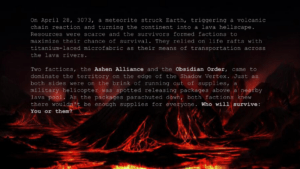
Box Sides (top, bottom, left, right)


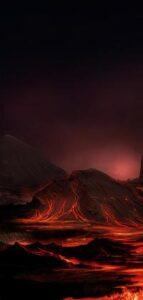
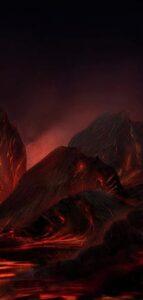
Rule Manual

Rafts (chairs)
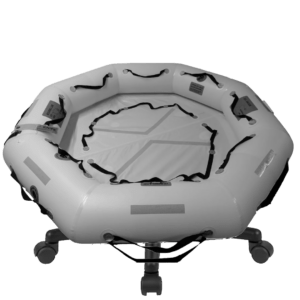
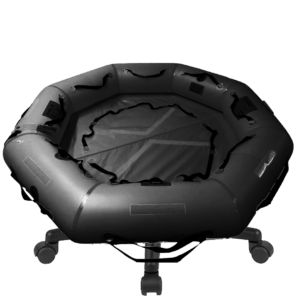
4x Ashen Alliance (left), 4x Obsidian Order (right)
Red Tape
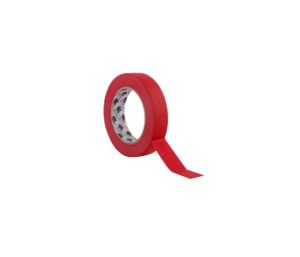
Final Playtest Video
4:06 — “This is such a scary game!”



